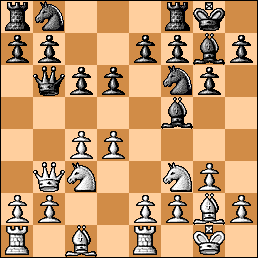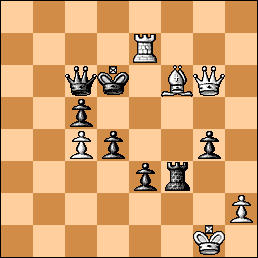2009 USCL Opening of the Week – Round 3
IM Jonathan Schroer – GM Joel Benjamin King’s Indian Defense
Two stalwart denizens of the 1980’s Manhattan Chess Club (located at the world-famous Carnegie Hall) go at it in 2009-style online combat.
1.d4 Nf6 2.c4 g6 3.Nf3 Bg7 4.g3 0-0 5.Bg2 d6 6.0-0 c6 7.Nc3 Bf5!?

Not Incredibly Strong but Not Stupid
There’s something positionally appealing about setting up a d6,c6 pawn chain, getting this bishop out, and preparing a later d5. In a related setup, black can try Nc6 (instead of c6) and then B to g4. Then his idea is hit in the center with e7-e5 after the N on f3 is diverted or traded.
For example, Ron Henley – MG Lone Pine 1980 went
1. d4 Nf6 2. Nf3 g6 3. g3 Bg7 4. Bg2 O-O 5. O-O d6 6. c4 Nc6 7. Nc3 Bg4!? Unusual but interesting. I can recommend this for further research to KID explorers out there.
8. Ne1 Qc8 9. b3 e5 10. d5 Ne7?
Here I go wrong and go ‘passive’. The bubbly 10… Nd4! is correct with level chances. For example, 11. f3 Bh3 12. e3 Bxg2 13. Kxg2 Nf5 14. Nc2 c5! and black is fine.
11. f3 Bh3 12. e4 Bxg2 13. Kxg2. White has a definite pull now and I was lucky to draw.
Let’s return to the diagram position. What should white do? This is the key theoretical moment.
8.b3?! White is giving too much respect to black’s offbeat idea. Our first guess based on prior evidence is that 8. Ne1! is correct. It accomplishes several aims. Mostly, it aims to establish a white square pawn chain and induce black to trade B/f5 for B/g2. Secondly, it prevents Nf6-e4 which is strong in the game!
Let’s look at 8. Ne1! more closely. We only give it an exclam here due to its success statistically in ChessBase prior games. As we shall see, this may be misguided.
After the possible followup 8…Qc8!? 9. e4 Bh3 10. f3 Bxg2 11. Kxg2 we reach another critical moment. In practice, white has been scoring very highly here with his space advantage. However, a single database game stands out for an interesting black response:
11. … c5! An amazing two-step with the black c-pawn. It makes sense! Rather than wait passively for a white build-up, black takes action to clarify the structure. On the other hand, WEAK is 11…e5? 12. dxe5 dxe5 13. Be3! with a pleasant exchange-KID style safe edge for white, who has gotten rid of his problem child light squared bishop! (Don’t remind Bruci Lopez about Exchange KIDs after he lost to Jesse Kraai in Weak 3 action, apparently an Altounian “special” delayed exchange variation because white cannot lose. And who, after all, wouldn’t mind a KID where white cannot lose!).
Let’s see this ingenious 11…c5!.

Position after 11…c5!
12. dxc5 Qxc5 and black is OK; or
12. d5 Nbd7 (in Amann-Martinovic, Austria 1998, the weaker 12…Na6 was played but black still drew) 13. Nc2 a6 and black has an acceptable Benoni with level chances. 12…Nh5 is also playable.
Well, let’s see, we might have to re-think and go back. Maybe 8. Ne1 is not so fearsome! What else? 8. Nh4 has been tried by such luminaries as Karpov and Portisch but that’s not dangerous; the WN is offside there. 8. Qb3!? is another try which has some logic, after all black’s Bf5 unguarded b7. After 8. Qb3!? Qb6 9. Re1!? (Wojo used to try this)

A Wojo Special
White emerges with a small edge after the optically scary 9…Qxb3(?!) 10. axb3 Bc2 11. b4 Na6 12. b5 Nb4 13. e4!. Wojo was a big openings expert so it makes sense to focus further research on his idea. Even so, black doesn’t have to take, and can play e.g. 9…Na6. His position looks fine.
Conclusion: there’s no clear path for a white advantage in this KID sideline!
Returning to the game, recall that Schroer has reacted cautiously and rather passively with 8. b3. This permits…
8… Ne4! Black is completely OK already; an opening success. In subsequent play Schroer vacillated between “solid” and “aggressive” with predictable results.
9.Bb2 Nxc3 10.Bxc3 Be4 11.Qd2 e6 12.Qe3 d5 13.Bh3 Bxf3 14.Qxf3 f5 15.Qd3 Nd7 16.f3 a5 17.Kh1 Qg5 18.Bg2 Qh5 19.Qe3 Rfe8 20.Qd3 Nf6 21.e4 dxe4 22.fxe4 Rad8 23.Rad1 c5 24.Bf3 fxe4 25.Bxe4 Ng4 26.Qe2 Rf8 27.Bf3 Rxf3 28.Rxf3 Nxh2 29.Kg2?
This has nothing to do with the opening, but the inhuman machine finds a way for white to get a half point here. 29. Qxe6+! Kh8 30. Rf7!! Qxd1+ 31. Kxh2 cxd4 (31…Qc2+ 33. Kh3 Qxc3 34. Rxg7! and draws) 32. Bxa5 Qh5+ 33. Kg1 Qxa5 34. Qe7 Rg8 35. Rxg7! with a draw! What a line!
29…Qxf3+ 30.Qxf3 Nxf3 31.Kxf3 b6 32.Ke4 cxd4 33.Rd3 e5 34.c5 bxc5 35.Bxa5 Ra8 36.Bb6 Rxa2 37.Bxc5 Re2+ 38.Kf3 Re1 39.Kf2 Rc1 40.b4 e4 41.Ra3 e3+ 42.Ke2 Rc2+ 43.Ke1 Be5 44.Ra8+ Kf7 45.Rf8+ Ke6 46.Re8+ Kd5 White resigns 0-1





















